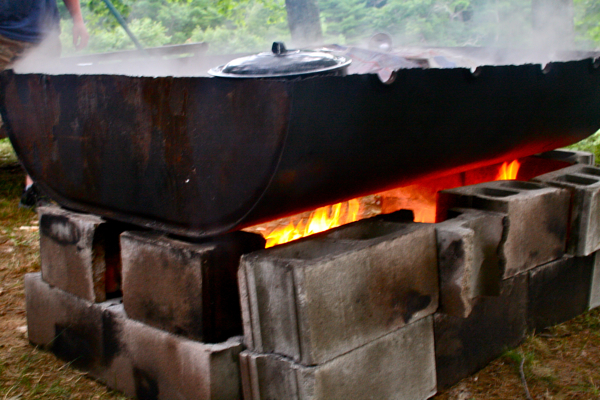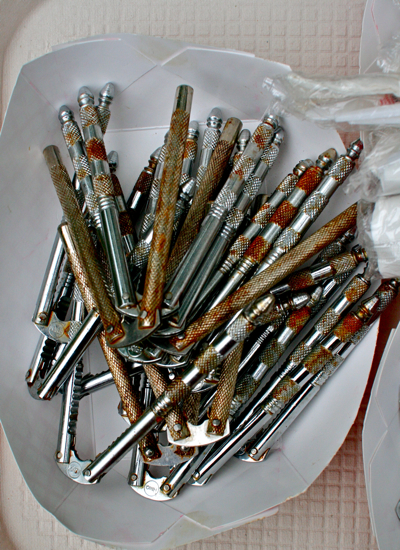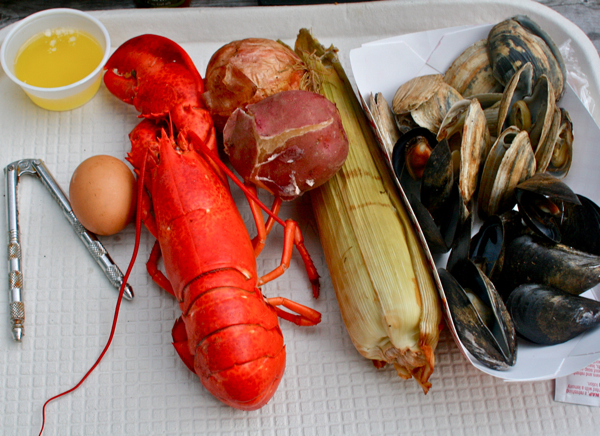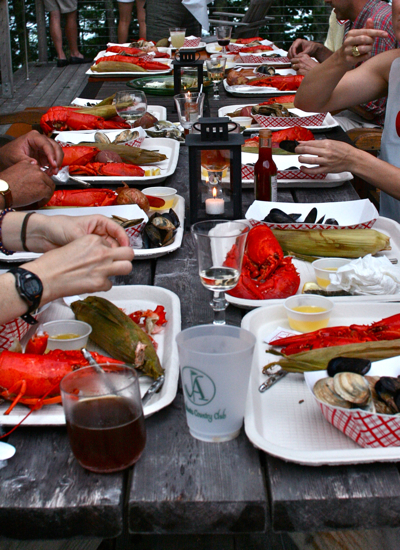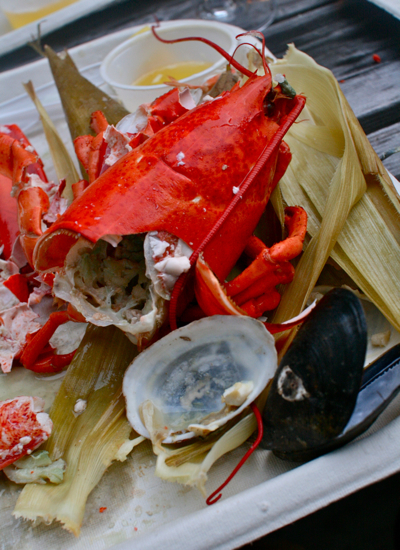We don’t roast goats in California. We don’t build big smokers in our backyards to patiently wait 12 hours until the meat practically falls off the bone. We don’t eat alligator or bison, and we certainly don’t hunt for our dinner. We don’t use that much mayo, we don’t make that much jello, and only recently have we discovered red velvet cake, but only in cupcake form. We think BBQ sauce belongs on pizza, and that salad is an entree. We don’t have lobster rolls or crab cakes, frito pie or key lime pie, and we don’t call fizzy drinks ‘pop’.
We also don’t dig holes in the ground to fill them up with hot coals and layers of fresh seafood and kelp.
Although, we should.
We should enthusiastically adopt all of those things, but mostly that last one about the seafood.
Growing up in California, I had no idea lobster and clam bakes existed. Not until I moved to New York did I hear Martha Vineyardites coming back from July 4 and Labor Day weekends, chatting about clam bake dinners and lobster roll lunches. Eating on the beach? With the ocean as your market? Corn, potatoes, and cholesterol-heavy seafood? Loved. It. I proceeded to be completely marveled with the novelty of the idea, and wondered if I ever would experience a true, bona-fide bake of my own.
So obviously, when I heard that Laura’s family was holding a lobster bake dinner to celebrate her birthday, I did a littlelobster dance.
But we had to wait through a whole day and a half in Maine before the grand dinner. It was torture. Fresh market yogurt – unpasteurized, of course – and homemade granola with tiny wild Maine blueberries. Tasty sandwiches from the local shop in the village. A delicious BBQ’d steak for dinner accompanied by too much of a creamy mushroom risotto (although, I rarely argue for too much risotto). And finally, pie from a famous local pie shop, with heaping scoops of rich vanilla ice cream. More yogurt and wild berries, and more sandwiches. In Maine, the folks seemed to enjoy providing the best of what the land and people can offer, and we happily obliged. So it’s no lie; it was torture – our tummies were crying out for mercy.
But some afternoon kayaking and a dip in the river soothed our full bellies, and as the sun slowly set across the Western horizon, we were miraculously running on empty again. Luckily, the two local lobstermen (brothers!) had arrived an hour earlier, and had built a fort of cinderblocks with a half drum propped in the middle.
Wet kelp is padded on the very bottom of the drum, and in it nestled a layer of onions, potatoes, and corn. On top of that goes a bit more kelp, then the lobsters are piled atop. Two nets, one filled with mussels, the other clams, are added. Finally, more kelp and a layer of wet newspapers cover the top. And of course, you can forget the pot of butter in the corner. Then a technique was explained that amused us all: eggs are placed on the top layer. As the heat slowly rises from the bottom up, the eggs will slowly cook. When the eggs are done – which usually takes about an hour – it is a signal that the seafood beneath is also done.
In the summers, these brothers go from house to house, party to party, building these lobster bakes and offering their catch to folks all over town. They can serve tiny parties, such as ours, of 20 or so people, and they can serve huge fetes, of upwards of 100 heads. That’s a LOT of lobster. The lobsters in Maine are always fresh caught. In fact, many lobstermen didn’t even go out to catch lobster last year since the yields were so incredibly high and prices got so low. The East Coast clearly needs to show the West Coast some lobster love. Diplomacy through crustaceans, yeahhh.
Oh, did I mention there were fresh OYSTERS?!
On the deck, enjoying some truly local Damariscotta oysters – a favorite of mine, for their size. Yum.
By the time we emerged from our showers, and coated with a healthy dose of bug spray, a fire had been raging beneath the homemade fire pit for quite some time. Clouds of smoke were bellowing from the pile of food and kelp. We had a glass of beer and some snacks – you know, to prepare our stomachs for what was to come. Approaching the fire, the air was thick with smoke and seafood. The official smell of Maine, perhaps. The lobstermen peeled off the top layers of kelp to reveal bright BRIGHT red lobsters. We got to taste the mussels from the nets, just to make sure they were ready – perfection.
Our party marched down to the fire and one by one, filled our trays with a bounty of edible delights. It was absolute gluttony at its finest. I loved the absence of forks and knives, and the fact that eating with both your hands and your mouth at the same time was totally acceptable. Conversation was minimal, less the obligatory “ohhmugawd thisissoooo gooood” groan that was uttered at least three times by each individual. Looking down the table, it was just a mad blur of lobsters, corn husks, and hands.
Before I knew it, it was over. The end came too quickly. I had two lobsters, and I’m embarrassed to say I could have had two more. The remains of dinner was a clear massacre, with seafood shells and small puddles of clarified butter and corncobs everywhere.
This experience was a blessing and a curse, because I know I’ll never be able to eat lobster quite as good ever again. Unless of course, I find myself in Maine. Oh, and of course, the company was just as good as the food. How could it not be, when you have little ones who entertain just by being themselves?
And then, we went inside to eat cake. When in Maine….

